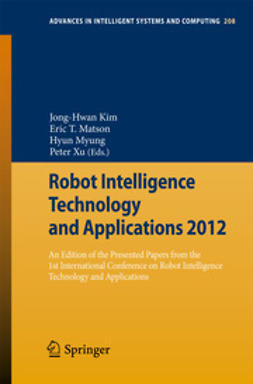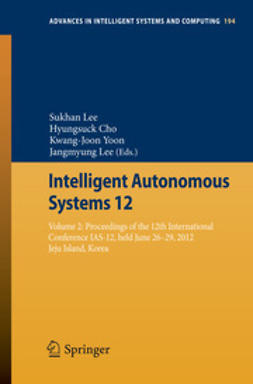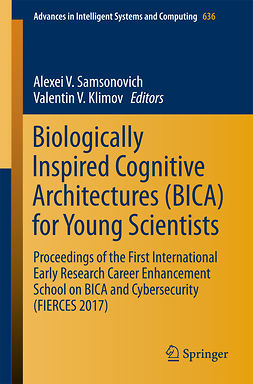Chella, Antonio
Biologically Inspired Cognitive Architectures 2012
1. Back to Basics and Forward to Novelty in Machine Consciousness
Igor Aleksander, Helen Morton
2. Characterizing and Assessing Human-Like Behavior in Cognitive Architectures
Raúl Arrabales, Agapito Ledezma, Araceli Sanchis
3. Architects or Botanists? The Relevance of (Neuronal) Trees to Model Cognition
Giorgio Ascoli
4. Consciousness and the Quest for Sentient Robots
Pentti O. A. Haikonen
5. Biological Fluctuation “Yuragi” as the Principle of Bio-inspired Robots
Hiroshi Ishiguro
6. Active Learning by Selecting New Training Samples from Unlabelled Data
Ho Gyeong Kim, Cheong-An Lee, Soo-Young Lee
7. Biologically Inspired beyond Neural: Benefits of Multiple Modeling Levels
Christian Lebiere
8. Turing and de Finetti Ganes: Machines Making Us Think
Ignazio Licata
9. How to Simulate the Brain without a Computer
Karlheinz Meier
10. Odor Perception through Network Self-organization: Large Scale Realistic Simulations of the Olfactory Bulb
Michele Migliore
11. Extending Cognitive Architectures
Alexei V. Samsonovich
12. Babies and Baby-Humanoids to Study Cognition
Giulio Sandini
13. Towards Architectural Foundations for Cognitive Self-aware Systems
Ricardo Sanz, Carlos Hernández
14. Achieving AGI within My Lifetime: Some Progress and Some Observations
Kristinn R. Thórisson
15. Learning and Creativity in the Global Workspace
Geraint A. Wiggins
16. Multimodal People Engagement with iCub
Salvatore M. Anzalone, Serena Ivaldi, Olivier Sigaud, Mohamed Chetouani
17. Human Action Recognition from RGB-D Frames Based on Real-Time 3D Optical Flow Estimation
Gioia Ballin, Matteo Munaro, Emanuele Menegatti
18. Modality in the MGLAIR Architecture
Jonathan P. Bona, Stuart C. Shapiro
19. Robotics and Virtual Worlds: An Experiential Learning Lab
Barbara Caci, Antonella D’Amico, Giuseppe Chiazzese
20. Comprehensive Uncertainty Management in MDPs
Vincenzo Cannella, Roberto Pirrone, Antonio Chella
21. A New Humanoid Architecture for Social Interaction between Human and a Robot Expressing Human-Like Emotions Using an Android Mobile Device as Interface
Antonio Chella, Rosario Sorbello, Giovanni Pilato, Giorgio Vassallo, Marcello Giardina
22. The Concepts of Intuition and Logic within the Frame of Cognitive Process Modeling
O. D. Chernavskaya, A. P. Nikitin, J. A. Rozhilo
23. Do Humanoid Robots Need a Body Schema?
Dalia Santis, Vishwanathan Mohan, Pietro Morasso, Jacopo Zenzeri
24. Simulation and Anticipation as Tools for Coordinating with the Future
Haris Dindo, Giuseppe Tona, Eric Nivel, Giovanni Pezzulo, Antonio Chella, Kristinn R. Thórisson
25. Solutions for a Robot Brain
Walter Fritz
26. Exemplars, Prototypes and Conceptual Spaces
Marcello Frixione, Antonio Lieto
27. The Small Loop Problem: A Challenge for Artificial Emergent Cognition
Olivier L. Georgeon, James B. Marshall
28. Crowd Detection Based on Co-occurrence Matrix
Stefano Ghidoni, Arrigo Guizzo, Emanuele Menegatti
29. Development of a Framework for Measuring Cognitive Process Performance
Wael Hafez
30. I Feel Blue: Robots and Humans Sharing Color Representation for Emotional Cognitive Interaction
Ignazio Infantino, Giovanni Pilato, Riccardo Rizzo, Filippo Vella
31. Investigating Perceptual Features for a Natural Human - Humanoid Robot Interaction Inside a Spontaneous Setting
Hiroshi Ishiguro, Shuichi Nishio, Antonio Chella, Rosario Sorbello, Giuseppe Balistreri, Marcello Giardina, Carmelo Calí
32. Internal Simulation of an Agent’s Intentions
Magnus Johnsson, Miriam Buonamente
33. A Model of Primitive Consciousness Based on System-Level Learning Activity in Autonomous Adaptation
Yasuo Kinouchi, Yoshihiro Kato
34. Decision-Making and Action Selection in Two Minds
Muneo Kitajima, Makoto Toyota
35. Cognitive Chrono-Ethnography: A Methodology for Understanding Users for Designing Interactions Based on User Simulation with Cognitive Architectures
Muneo Kitajima, Makoto Toyota
36. Emotional Emergence in a Symbolic Dynamical Architecture
Othalia Larue, Pierre Poirier, Roger Nkambou
37. An Integrated, Modular Framework for Computer Vision and Cognitive Robotics Research (icVision)
Jürgen Leitner, Simon Harding, Mikhail Frank, Alexander Förster, Jürgen Schmidhuber
38. Insertion Cognitive Architecture
Alexander Letichevsky
39. A Parsimonious Cognitive Architecture for Human-Computer Interactive Musical Free Improvisation
Adam Linson, Chris Dobbyn, Robin Laney
40. Cognitive Integration through Goal-Generation in a Robotic Setup
Riccardo Manzotti, Flavio Mutti, Giuseppina Gini, Soo-Young Lee
41. A Review of Cognitive Architectures for Visual Memory
Michal Mukawa, Joo-Hwee Lim
42. A Model of the Visual Dorsal Pathway for Computing Coordinate Transformations: An Unsupervised Approach
Flavio Mutti, Hugo Gravato Marques, Giuseppina Gini
43. Multiagent Recursive Cognitive Architecture
Zalimkhan V. Nagoev
44. A Biologically-Inspired Perspective on Commonsense Knowledge
Pietro Perconti
45. Coherence Fields for 3D Saliency Prediction
Fiora Pirri, Matia Pizzoli, Arnab Sinha
46. Principles of Functioning of Autonomous Agent-Physicist
Vladimir G. Red’ko
47. Affect-Inspired Resource Management in Dynamic, Real-Time Environments
W. Scott Neal Reilly, Gerald Fry, Michael Reposa
48. An Approach toward Self-organization of Artificial Visual Sensorimotor Structures
Jonas Ruesch, Ricardo Ferreira, Alexandre Bernardino
49. Biologically Inspired Methods for Automatic Speech Understanding
Giampiero Salvi
50. Modeling Structure and Dynamics of Selective Attention
Hecke Schrobsdorff, Matthias Ihrke, J. Michael Herrmann
51. How to Engineer Biologically Inspired Cognitive Architectures
Valeria Seidita, Massimo Cossentino, Antonio Chella
52. An Adaptive Affective Social Decision Making Model
Alexei Sharpanskykh, Jan Treur
53. A Robot Uses an Evaluation Based on Internal Time to Become Self-aware and Discriminate Itself from Others
Toshiyuki Takiguchi, Junichi Takeno
54. Why Neurons Are Not the Right Level of Abstraction for Implementing Cognition
Claude Touzet
55. Intertemporal Decision Making: A Mental Load Perspective
Jan Treur
56. A Non-von-Neumann Computational Architecture Based on in Situ Representations: Integrating Cognitive Grounding, Productivity and Dynamics
Frank Velde
57. A Formal Model of Neuron That Provides Consistent Predictions
E. E. Vityaev
58. Safely Crowd-Sourcing Critical Mass for a Self-improving Human-Level Learner/“Seed AI”
Mark R. Waser
59. Unconscious Guidance of Pedestrians Using Vection and Body Sway
Norifumi Watanabe, Takashi Omori
60. The Analysis of Amodal Completion for Modeling Visual Perception
Liliana Albertazzi, James Dadam, Luisa Canal, Rocco Micciolo
61. Naturally Biased Associations between Colour and Shape: A Brentanian Approach
Liliana Albertazzi, Michela Malfatti
62. Architecture to Serve Disabled and Elderly
Miriam Buonamente, Magnus Johnsson
63. Bio-inspired Sensory Data Aggregation
Alessandra Paola, Marco Morana
64. Clifford Rotors for Conceptual Representation in Chatbots
Agnese Augello, Salvatore Gaglio, Giovanni Pilato, Giorgio Vassallo
65. Neurogenesis in a High Resolution Dentate Gyrus Model
Craig M. Vineyard, James B. Aimone, Glory R. Emmanuel
66. A Game Theoretic Model of Neurocomputation
Craig M. Vineyard, Glory R. Emmanuel, Stephen J. Verzi, Gregory L. Heileman
Nyckelord: Engineering, Computational Intelligence, Artificial Intelligence (incl. Robotics), Neurosciences
- Författare
- Chella, Antonio
- Pirrone, Roberto
- Sorbello, Rosario
- Jóhannsdóttir, Kamilla Rún
- Utgivare
- Springer
- Utgivningsår
- 2013
- Språk
- en
- Utgåva
- 2013
- Serie
- Advances in Intelligent Systems and Computing
- Sidantal
- 16 sidor
- Kategori
- Teknologi, energi, trafik
- Format
- E-bok
- eISBN (PDF)
- 9783642342745











